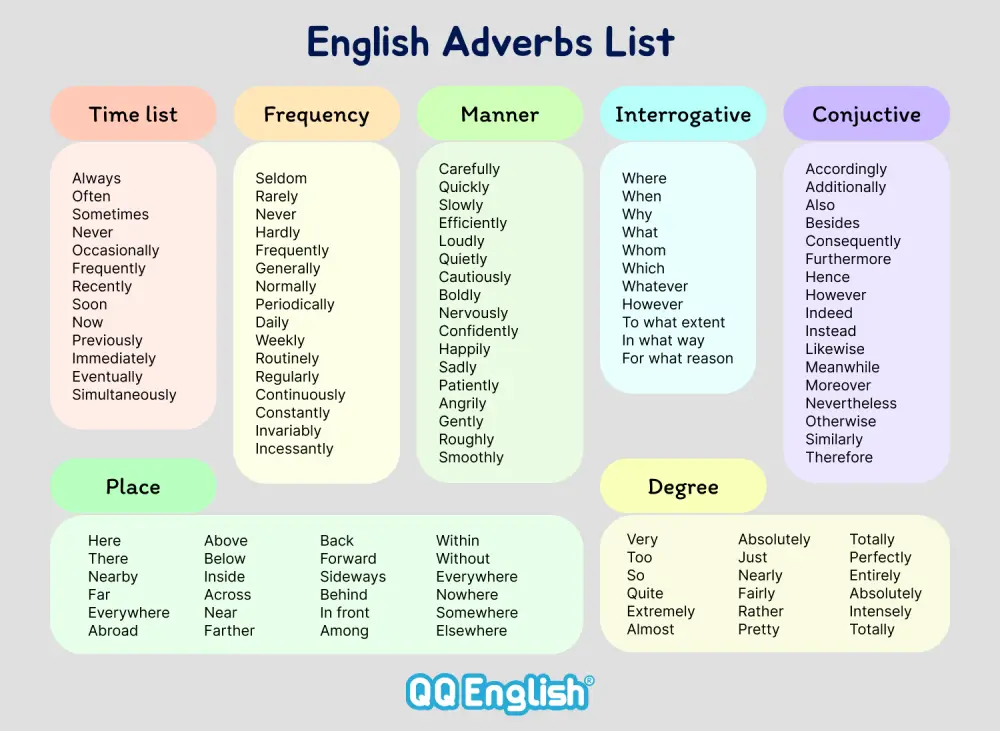ADVERBS: Learning basic English grammar - What is an Adverb?
In English, adverbs are words that describe a verb (he runs quickly), an adjective (very hot), another adverb (finished too quickly), or even an entire sentence (Luckily, I passed the exam). In most times, adverbs end in -ly, but some (such as fast) look exactly the same as their adjective counterparts.
Grammatically, we also have conjunctive adverbs in English. These adverbs form a separate category as they function both as conjunctions (words that connect) and adverbs (modifying words).
English adverbs have several types – degree, frequency, manner, place, and time, comment, conjunction, and confirmation and negation.
Before we talk more about the types of adverbs, let us first learn how adverbs function in the sentence.
Let us consider the following explanation below.
1. An adverb can modify a verb.
The dog barks loudly after he saw the stranger standing outside. (The adverb loudly modifies the verb bark by telling how.)
Wash your hands first and then eat your breakfast. (The adverb first modifies the verb wash, and the adverb then modifies the verb eat. Both modify the verbs by telling when.)
She went upstairs after her mother scolded her. (The adverb upstairs modifies the verb went by telling where.)
2. An adverb can describe an adjective. The adverb usually clarifies the degree or intensity of the adjective.
Tom was almost done with his meal when I gave him the exceptionally mouth-watering chocolate cake. (The adverb almost modifies the adjective done and exceptionally modifies mouth-watering by describing the degree or intensity of the adjectives.)
Her mother was very proud of her for being an absolutely amazing chess player. (The adverb very modifies the adjective proud and extremely modifies amazing by describing the degree or intensity of the adjectives.)
3. An adverb can modify another adverb. The modifying adverb usually clarifies the degree or intensity of the adverb.
She can speak English very fluently. (The adverb very modifies the adverb thoroughly by telling to what degree.)
I was never completely unaware that the jewelry I bought was fake. (The adverb never modifies the adverb completely by telling to what degree.)
Adverbs Vs. Adjectives and Nouns
As mentioned above, English adverbs generally end in -ly but not all words ending in -ly are adverbs. Tricky as it looks, some -ly ending words can either be nouns or adjectives.
Adverbs are often made by adding -ly to an adjective.
1. adjective: hard adverb: hardly
2. adjective: quick adverb: quickly
3. adjective: gentle adverb: gently
4. adjective: soft adverb: softly
5. adjective: loud adverb: loudly
HOWEVER, not all words that end in -ly are adverbs! In some cases, noun + -ly often results in an adjective.
NOUNS:
family
homily
rally
lily
silly
sly
ADJECTIVES:
friend + ly = friendly
world + ly = worldly
love + ly = lovely
mother + ly = motherly
Some common adverbs do not originate from adjectives.
very
quite
so
well
Some adverbs modify by negating a statement, meaning they express a negative thought. We call these negative adverbs in English.
hardly
never
no
not
scarcely
N.B. When using negative adverbs, be careful to avoid a double negative.
(Incorrect double negative)
I can’t hardly understand what he is talking about.
(Correct)
I can hardly understand what he is talking about.
Moreover, we form the comparative or superlative forms of adverbs by adding -er or -est to certain adverbs of only one syllable (quick, quicker, quickest).
But it is also very important to remember that adverbs of more than one or two-syllable form their comparative and superlative form by adding more or most.
Tess learns quickly than Tom does, but Tom gets a higher score in exams because he studies more often than Tess. Jack learns most slowly among them.

Conjunctive Adverbs
Conjunctive adverbs are words used to connect one clause to another. They are also used to show sequence, contrast, cause and effect, and other relationships. Additionally, these types of adverbs also function as conjunctions (joining grammatical parts) are called conjunctive adverbs.
Examples of Conjunctive Adverbs:
accordingly
finally
likewise
similarly
also
furthermore
meanwhile
anyway
next
then
consequently
indeed
nonetheless
therefore
conversely
instead
otherwise
thus
Conjunctive adverbs connect and create transitions between independent clauses. Sometimes, a conjunctive adverb may start a sentence and is often followed by a comma. When place between independent clauses, we put a semicolon after the conjunctive adverb and then followed by a comma.
The conjunctive adverbs in the following examples are in bold for easy identification.
1. Ana kept talking in class; therefore, she got reprimanded by her teacher.
2. I thought she’s a good person; however, I found out she was mean and impolite.
3. Diamonds are very expensive; in fact, a 0.5-carat diamond costs about $1 500.
4. You’re my friend; nonetheless, I feel like you’re taking advantage of me.
5. The new iPhone 12 is so costly; on the other hand, its features are the best in the market so far.
Adverb Phrases and Adverb Clauses
Adverbial phrases and adverbial clauses tell us when, where, how, or why an action occurs.
For example:
A one-word adverb: The championship will take place tomorrow.
An adverbial phrase: The championship will take place in the afternoon.
(A phrase does not contain a subject and a verb.)
An adverbial clause: The championship will take place when both teams are ready.
(A clause contains a subject (“both teams”) and a verb (“are”).)
Adverb prepositional phrase
An adverb prepositional phrase describes a verb, adjective, or adverb. It usually tells when, where, how, why, or to what extent (how many, how much, how long, or how far), and under what condition.
Modifying a verb:
They always go \to the club \on the weekends. (Where and when we go.)
Modifying an adjective:
Lisa is very good \at dancing. (Under what condition is she good?)
Modifying an adverb:
I like sleeping early \in the evening. (How early?)
Adverb dependent clause
A dependent adverb clause is a group of words that play the role of an adverb and that contains a subject and a verb. It tells us when, where, why, how, how often, or under what condition the main verb in the sentence takes place.
The manager left before I arrived in the office. (Before I arrived in the office is a dependent clause that modifies the verb departed by telling when.)
When to avoid adverbs
Ernest Hemingway is often held up as an example of a great writer who detested adverbs and advised other writers to avoid them. In reality, it’s impossible to avoid adverbs altogether. Sometimes we need them, and all writers (even Hemingway) use them occasionally. The trick is to avoid unnecessary adverbs. When your verb or adjective doesn’t seem powerful or precise enough, instead of reaching for an adverb to add more color, try reaching for a stronger verb or adjective instead. Most of the time, you’ll come up with a better word and your writing will be stronger for it.
Want to learn more about the Eight Parts of Speech in English? Click this heck out THIS to learn more.



